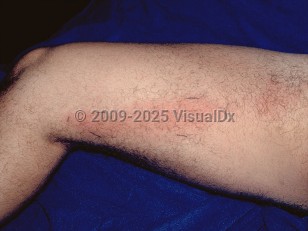Cellulitis in Infant/Neonate
See also in: Cellulitis DDx,Anogenital,Hair and Scalp,Oral Mucosal LesionAlerts and Notices
Important News & Links
Synopsis

Neonatal cellulitis (seen in infants younger than age 3 months) is an uncommon inflammatory bacterial infection of deep dermis and subcutaneous tissues often caused by group B Streptococcus (GBS).
In cellulitis, bacteria invade through small cracks, fissures, or breaks in the skin. The clinical manifestations include rapidly progressive areas of skin edema, erythema, heat, and pain with or without associated lymphangitis or adenopathy. In this age group, risk factors for GBS should be considered, which include GBS colonization of the birthing parent, mode of delivery, episiotomy, prematurity, hospitalization, and prior antibiotic treatment.
It is unlikely for infants aged younger than 60 days who have skin and soft tissue infections (SSTIs) to develop sequela such as bacterial meningitis, osteomyelitis, or urinary tract infections (UTIs). However, bacteremia may be seen in up to 1%-2% of infant patients with SSTIs; this rate can be much higher in febrile infants with cellulitis.
GBS Cellulitis-Adenitis Syndrome: This is a rare, late-onset infection with GBS that presents with cellulitis and lymphadenitis, cellulitis alone, or more rarely, with lymphadenitis alone. It most often presents with accompanying bacteremia and sometimes meningitis. The cellulitis most often occurs on the head and neck (particularly the submandibular area), followed by the inguinal region. This infection often occurs in male infants and in infants who were born prematurely and with a low birth weight. Clinical manifestations include irritability, fever, enlarged lymph nodes, and cutaneous signs of cellulitis (such as erythema and swelling).
Related topics: orbital cellulitis, preseptal cellulitis
In cellulitis, bacteria invade through small cracks, fissures, or breaks in the skin. The clinical manifestations include rapidly progressive areas of skin edema, erythema, heat, and pain with or without associated lymphangitis or adenopathy. In this age group, risk factors for GBS should be considered, which include GBS colonization of the birthing parent, mode of delivery, episiotomy, prematurity, hospitalization, and prior antibiotic treatment.
It is unlikely for infants aged younger than 60 days who have skin and soft tissue infections (SSTIs) to develop sequela such as bacterial meningitis, osteomyelitis, or urinary tract infections (UTIs). However, bacteremia may be seen in up to 1%-2% of infant patients with SSTIs; this rate can be much higher in febrile infants with cellulitis.
GBS Cellulitis-Adenitis Syndrome: This is a rare, late-onset infection with GBS that presents with cellulitis and lymphadenitis, cellulitis alone, or more rarely, with lymphadenitis alone. It most often presents with accompanying bacteremia and sometimes meningitis. The cellulitis most often occurs on the head and neck (particularly the submandibular area), followed by the inguinal region. This infection often occurs in male infants and in infants who were born prematurely and with a low birth weight. Clinical manifestations include irritability, fever, enlarged lymph nodes, and cutaneous signs of cellulitis (such as erythema and swelling).
Related topics: orbital cellulitis, preseptal cellulitis
Codes
ICD10CM:
L03.90 – Cellulitis, unspecified
SNOMEDCT:
128045006 – Cellulitis
L03.90 – Cellulitis, unspecified
SNOMEDCT:
128045006 – Cellulitis
Look For
Subscription Required
Diagnostic Pearls
Subscription Required
Differential Diagnosis & Pitfalls

To perform a comparison, select diagnoses from the classic differential
Subscription Required
Best Tests
Subscription Required
Management Pearls
Subscription Required
Therapy
Subscription Required
References
Subscription Required
Last Reviewed:03/13/2023
Last Updated:05/13/2025
Last Updated:05/13/2025
 Patient Information for Cellulitis in Infant/Neonate
Patient Information for Cellulitis in Infant/Neonate
Premium Feature
VisualDx Patient Handouts
Available in the Elite package
- Improve treatment compliance
- Reduce after-hours questions
- Increase patient engagement and satisfaction
- Written in clear, easy-to-understand language. No confusing jargon.
- Available in English and Spanish
- Print out or email directly to your patient
Upgrade Today

Cellulitis in Infant/Neonate
See also in: Cellulitis DDx,Anogenital,Hair and Scalp,Oral Mucosal Lesion
